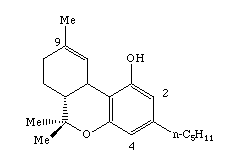| delta 9-THC |
|---|

|
| delta 9-THC |
|---|

|
Chemically the cannabinoids are classed as terpenoid (terpene like) these compounds occur as essential oils within many plants and some are involved in vitamin, steroid and pigment formation.
The cannabinoids are fundamentally non-polar molecules, with low solubility in water, so they are normally self-administered by smoking. The volatilised fractions are inhaled as a vapour and a varying amount utilised depending on the smoking technique.
Biological effects of the cannabinoids include:
relaxation, floating sensation and depersonalisation (leading to out-of-body experiences), percetual changes (visual, auditory and tactile), slowing of time, loss of attention, euphoria and silliness.Comparisons may be made with alcohol and a debate about the two compound types usually leads to an interesting discussion, ultimately involving the subject of legalisation.
Apart from the trivial recreational uses/abuses aside, the cannabinoids find important medicinal use in the control of nausea (vomitting) induced by chemotherapy of cancer patients especially when toxic drugs are employed.
the structure file was created using initial co-ordinates from the Chemical Databank Service Crystallographic (CSSR) database at Daresbury, UK and energy minimised within Nemesis (Oxford Molecular) software, saving as a Brookhaven PDB file format.
Mechoulam.R etal, Biochem.Pharmacol. 48, 1994, 1537-1544.
Kolter.T and Sandhoff.K, Angew.Chem.Int.Ed.Engl, 1995, 34, 2363-4.
![]() Back to Molecule of the Month page. [DOI:10.6084/m9.figshare.5469670]
Back to Molecule of the Month page. [DOI:10.6084/m9.figshare.5469670]